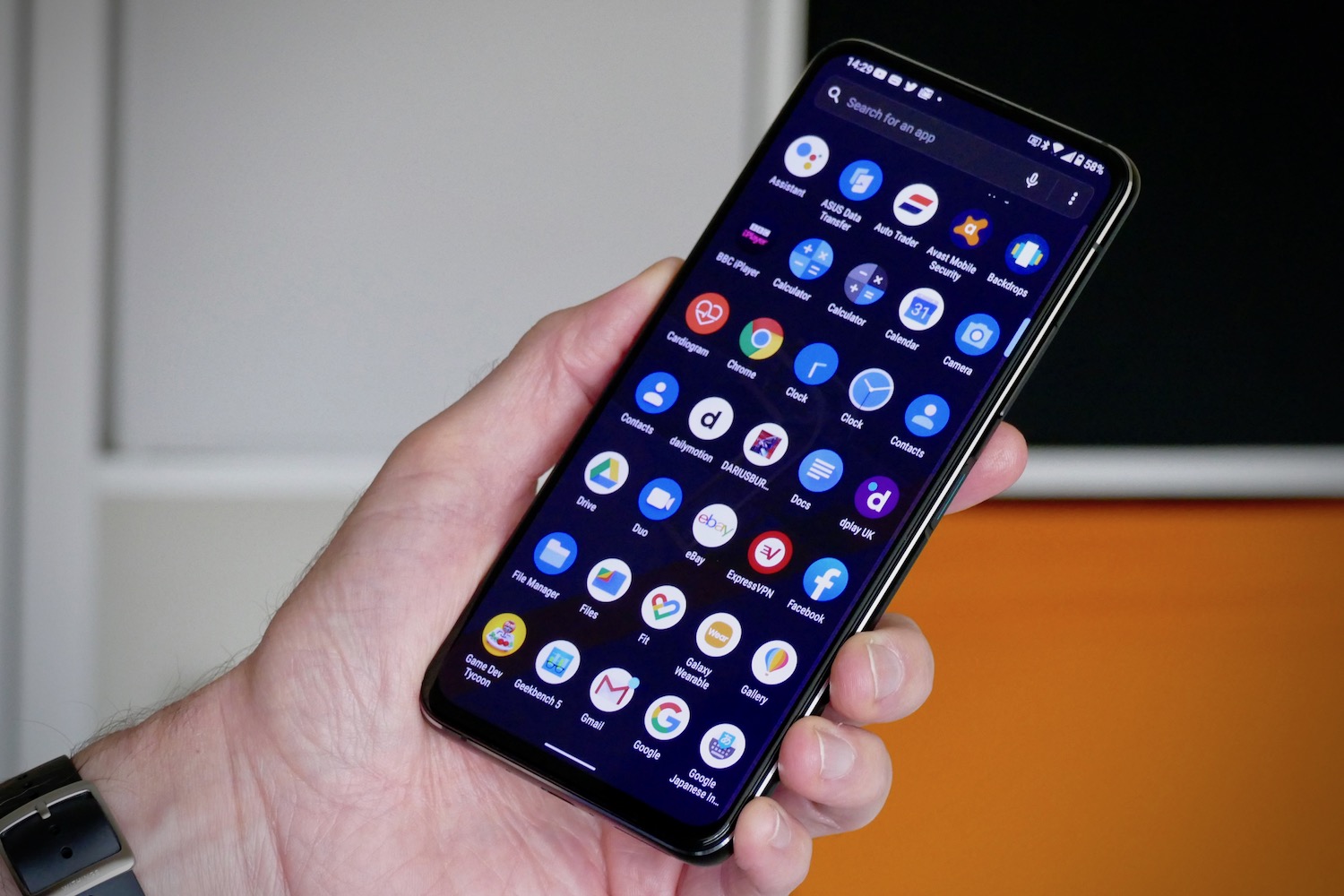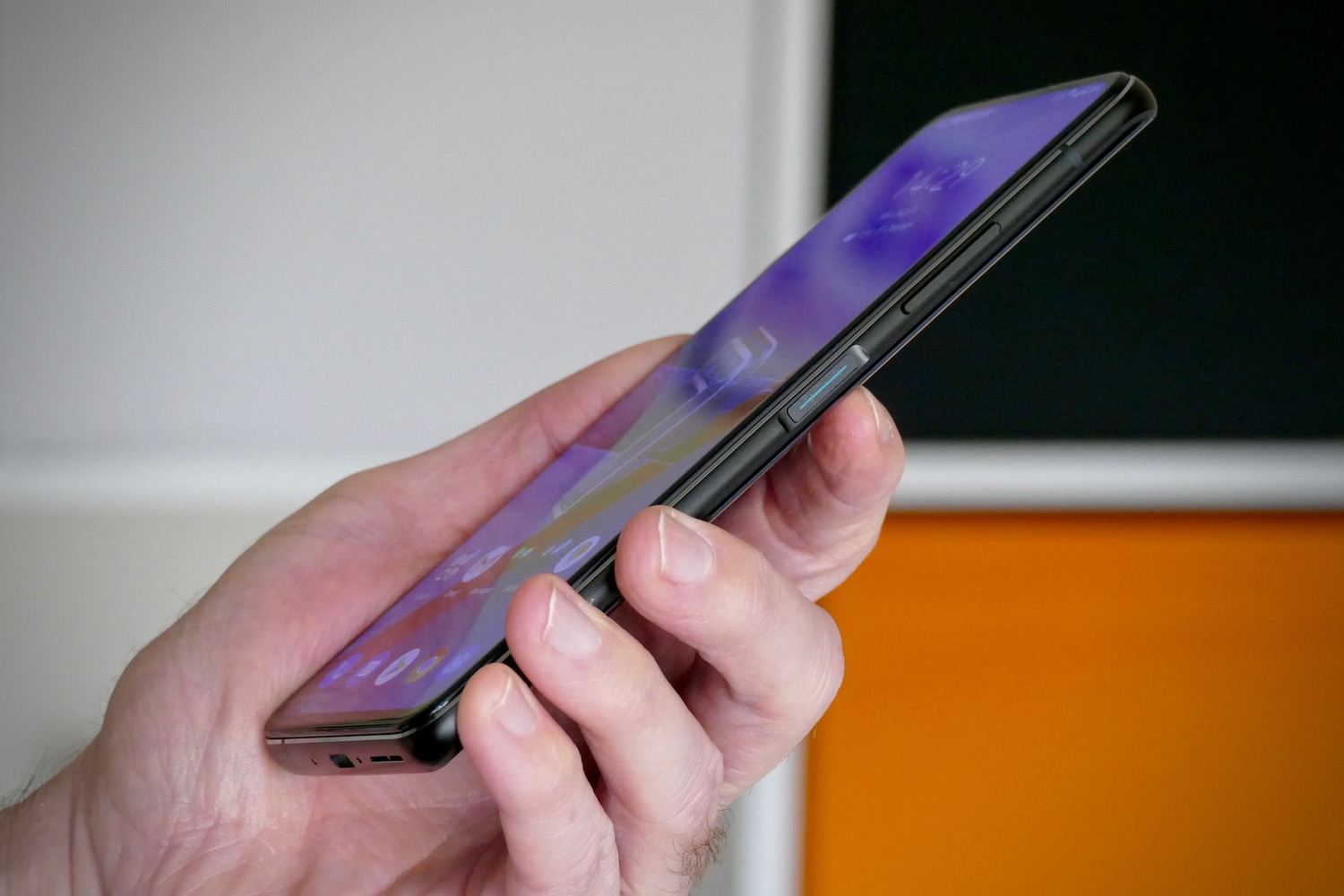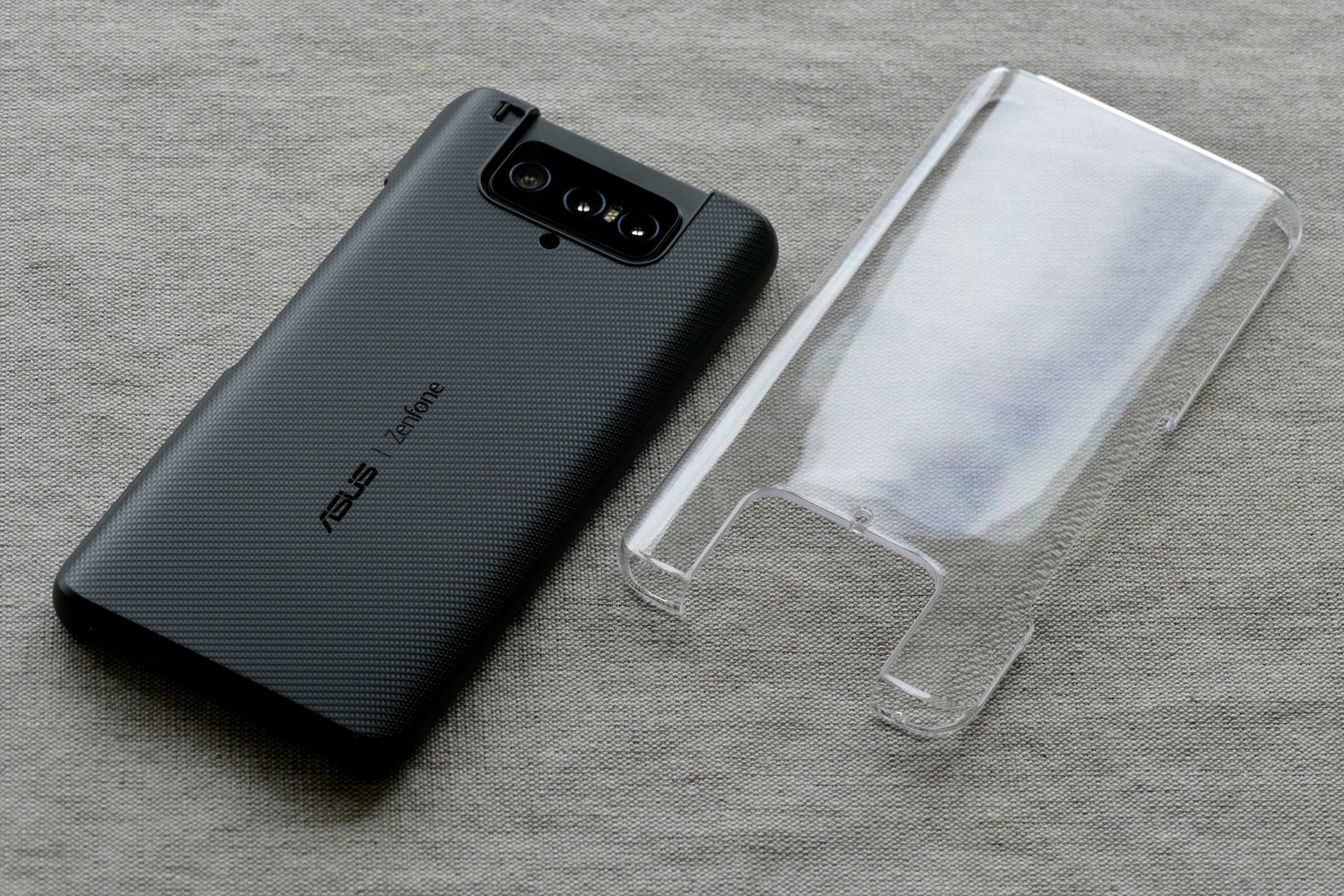“The ZenFone 7 Pro's motorized flip camera means the phone has the most versatile selfie camera available today”
- Rear camera is feature-packed
- Front camera is the best you can get
- Bright, colorful screen
- Long-lasting battery
- No water resistance
- Heavy
For the ZenFone 7 Pro Asus has brought back the motorized flip camera it introduced on the ZenFone 6, but boosted its ability and feature list to make this a dream phone for the selfie lover. Everything you can do with the rear camera — wide-angle, 8K video recording, super sharp telephoto — you can do for selfies, and that makes it very special indeed.
The rest of the specification has been given a bump, too, and therefore the price has gone up over the previous model, so should you still consider the ZenFone 7 Pro if selfies aren’t that important to you? Let’s find out.
Design
Asus wants to build your muscles. The Zenfone 7 Pro weighs 230 grams, considerably more than most big flagship devices, so grab this and the 240 gram ROG Phone 3 to increase the intensity of your home workout. It’s thick at 9.6mm, and you really do notice the size and bulk of the Zenfone 7 Pro when comparing it to its closest rivals, the OnePlus 8, the LG Velvet, and the iPhone 11. The weight is fairly evenly distributed, but definitely biased toward the top of the phone due to the motorized flip camera module.

The camera module is a significant improvement over the Zenfone 6. It fits flush with the body and doesn’t move when you shake the phone around, mostly eliminating annoying rattles. It’s made from strong and light liquid metal but is bigger than the Zenfone 6’s, however I think it looks better because of this. The motor has been re-engineered from the original and is quiet and fast, but the software often prompts you to perform a recalibration check, especially after the phone takes a knock.
The larger flip module is not the only visual improvement. The slimmer bezels around the screen give the phone a great modern look, and moving the fingerprint sensor to the side does the same. The sensor performs different functions, such as a double tap to open Google Assistant, or it can be programmed to open your own choice of app. Thankfully, the addition of new features has not affected the speed or accuracy of the fingerprint sensor, and it works very well.

The back of the Zenfone 7 Pro is made of glass, but it doesn’t really feel like it, and is so slippery it feels like it has been greased from the factory. The panel is warm to the touch and surprisingly flexible, with an almost hollow sound when you tap it. The green, almost blue color is attractive, but the tactility of the panel itself is not as pleasing as the OnePlus 8 Pro or the LG Velvet, or as comfortable to hold as the Huawei P40 Pro, plus without much grip the heft means sometimes it requires two hands to hold.
The glass back doesn’t feel cheap, but I do question the durability, which is a concern in a phone of this size, weight, and slipperiness. Asus may know this, as it includes two cases in the box — a rugged case, and a transparent one. I suggest you use one. The fact that the otherwise perfectly acceptable looking ZenFone 7 Pro is a serious 40 grams heavier than the ZenFone 6 is an unfortunate misstep, and makes living with it more arduous than it should be.
Screen
Bigger, wider, brighter, and more colorful sums up the differences between the ZenFone 7 Pro compared to the ZenFone 6. It’s a 6.67-inch AMOLED panel with a 90Hz refresh rate and a 20:9 aspect ratio. Asus has even employed the special tuning that makes the ROG Phone 3’s display so pretty on the 7 Pro. Asus isn’t wrong about the brightness either, it’s stunning, and even makes the

It’s not quite so natural to look at though. Watching Carfection’s Ferrari F8 Spider review on YouTube the road isn’t as atmospherically gray as it is on the iPhone, and the yellow car pops off the screen with such aggression, you’ll reach for your sunglasses. If you like high-energy AMOLED screens with borderline radioactive colors, the ZenFone 7 Pro will not disappoint. Watching video does reveal the slightly tinny sound from the stereo speakers though, and it would have been great to hear the same brilliant Dirac-tuned audio from the ROG Phone 3 on the ZenFone 7 Pro.

It’s worth talking about the screen’s overall responsiveness here. The 90Hz refresh rate should be considered a standard at this price, but it’s neatly augmented by a one-millisecond response time and a 200Hz touch sampling rate. What does this mean? The ZenFone 7 Pro always feels snappy, responsive, and fluid, regardless of the app you use, which along with some software optimizations for speed means the phone always feel modern and high performance.
The flip camera avoids the need for a notch or hole-punch, enhancing the cinematic view. If you notice the notch or hate the hole-punch, the ZenFone 7 Pro’s pretty to look at, uninterrupted screen will be exactly what you want.
Camera
The Asus Zenfone 7 Pro has the best selfie camera in the business, bar none. If selfies fill your gallery app, then this phone will give you many opportunities to get creative, with masses of features, modes, and overall ability than any other selfie camera you’ve used before. How is this possible? It’s Asus’s decision to make the rear camera the front camera, too, using the motorized flip module.

What you get is a 64-megapixel Sony IMX686 main camera sensor with an f/1.8 aperture, 8K video recording, and optical image stabilization, plus a 12-megapixel ultra-wide sensor, and an 8-megapixel telephoto lens with optical image stabilization and a 3x optical zoom. Features include
To make it clear, all these features are available on the selfie camera, and the results are dramatic. Colors are vibrant, exposure is spot-on, edge detection in portrait mode is excellent, and when’s the last time you shot 8K video with a selfie camera, or took an expansive, 113-degree, ultra-wide selfie? With the ZenFone 7 Pro, you can do all this and more.
The flip module itself has been redesigned and re-engineered to be tougher, faster, and more powerful. It does require periodic calibrations, but Asus says its endurance tests show it’s good for 100 flips per day for five years, making it twice as strong as the ZenFone 6’s module. It’s more adjustable too. You can move the module from flat to fully flipped in stages of 0.5 degrees, and doing so is very fluid.
From an engineering standpoint, it’s a work of art, and does enable some fun features. The auto panorama feature is excellent, with very effective stitching and a truly wide scale. It isn’t immediately obvious how to best make use of the module’s adjustable angle, but once you start to experiment you notice it’s not often about the photos it lets you take, but the benefits of being able to keep the screen at an angle you can properly frame different shots, such as from low down without guessing on the framing or laying down on the ground.
I’m also impressed by the consistency between the standard and wide-angle camera, with shots appearing similarly dynamic from both, although at 3x optical zoom, photos can be a little drab. It also repeatedly warns you’re too close to a subject and to move back for better focus when taking close up shots, despite the final photo being focused correctly.
Overall though, I’ve really enjoyed using the ZenFone 7 Pro’s camera, and exploring how best to use its fun motorized module. I don’t feel like I’ve scratched the surface of what it can do yet either, and that’s a good feeling to have. It’s unfortunate the flip module contributes to some of the phone’s downsides — weight, and lack of water resistance for example — but there’s no denying the ZenFone 7 Pro is the phone of choice for selfie connoisseurs.
Software and performance
The Zenfone 7 Pro uses the Qualcomm Snapdragon 865 Plus processor with 8GB of
Geekbench 5: 3125 Multi Core/980 Single Core
3DMark Sling Shot Extreme: 7,706 (OpenGL)
These scores are a little down on the Asus ROG Phone 3, but it does have less
Asus is stuck when it comes to
No such conundrum exists with the software, as Asus continues to build ZenUI into a neat, usable, relatively bloat-free version of
Battery
Asus talks a lot about extending battery life, not really on a daily basis, but over the lifetime of the phone itself. It presents charts and data about how overnight charging, wireless charging, mega-fast wired charging, and other battery bad habits (according to Asus, at least) reduce the cell’s capacity to hold a charge over years of ownership. For the ZenFone 7 Pro it has taken steps to reduce long-term battery degradation and help it retain capacity for longer.

The cornerstone of this battery care system is a slow-charge option, where the battery is charged to 80% when you first plug it in at night, and then the final 20% is zapped in a short while before your scheduled wake-up time. You can tweak this to only charge at scheduled times, or even never charge the battery fully at all, just to protect it over time. Dive even deeper and you can shut down apps, prevent them from auto starting, and limit background activity, too.

Wireless charging isn’t onboard due to Asus’s battery concerns, along with such a function taking up even more space inside the already-big phone, but that hasn’t stopped the ZenFone 7 Pro from coming with a wired fast charger. It zips to 60% in 35 minutes, and on to 100% in 90 minutes. Usage time is good, but not unbelievable. With moderate use I have gotten two days from the ZenFone 7 Pro’s battery, but heavy use with the camera, gaming, and video calls really hits it hard, and on those days at around 11 p.m. the battery was down to 5%.
Make no mistake, you won’t have any single-day battery anxiety here, but don’t expect it to last two full days when you use it hard.
Price and availability
Asus has announced the Taiwanese and European price for the ZenFone 7 Pro, but has not confirmed the U.S. price yet. It costs 799 euros, which converts over to $950. However, based on how Asus has converted prices in the past, the ZenFone 7 Pro may end up being around $799.
The final release date has not been confirmed, but Asus does recognize it was difficult to find a ZenFone 6 for sale, and has said there will be greater supply for the ZenFone 7 Pro. We will update here when we find out more about U.S. availability.
Our Take
The ZenFone 7 Pro’s flip camera makes it absolutely the best
Is there a better alternative?
Yes. The ZenFone 7 Pro’s biggest downside is the overall size and weight of the device, and if this is a concern for you, there are several considerably slimmer and lighter phones available for around the same price. The $700 OnePlus 8 is a great everyday phone with reliable software and a good camera wrapped in a 180-gram body. The $600 LG Velvet is also 180 grams and even better looking than the OnePlus 8, has water resistance, and an excellent screen.
Alternatively, the $700 iPhone 11 is still excellent, despite a replacement being on the horizon, with plenty of power, good battery life, and a capable camera. Want something a little different? Take a look at the $700 Motorola Moto Edge with its stunning screen, great battery life, and unusual design.
How long will it last?
The ZenFone 7 Pro isn’t water resistant but does come with a decent rugged case, which should protect it from too much harm. The phone’s specification is good, and Asus promises two major
Should you buy it?
Yes. For taking selfies, there’s no other phone that comes close to the ZenFone 7 Pro, and happily the rest of the phone impresses, too.
























